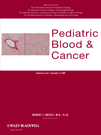Prolonged acquired neutropenia in children
Abstract
Background
Acquired neutropenia is not uncommon in childhood. This study investigated the risk factors associated with developing prolonged acquired neutropenia.
Procedure
We reviewed 66,062 hospital admission medical records from the 5-year period January 1, 2002 to December 31, 2006 to identify neutropenic patients, with and without follow-up of their neutropenic course until December 31, 2007. After excluding patients with malignancy, collagen disease, bone marrow failure, prematurity, hereditary disease, congenital neutropenia, immunodeficiency, or status post-liver transplantation, 735 admissions with acquired neutropenia were included in our study.
Results
A total of 474 patients with 735 admissions had moderate or severe neutropenia during the 5-year period. Among the 252 acquired neutropenia patients who had follow-up for at least 1 month, 226 patients recovered within 3 months, while 26 patients remained neutropenic after 3 months. Of these 26 patients, 14 recovered after 1 year. An absolute neutrophil count of <500/mm3 (odds ratio [OR]: 13.66, 95% confidence interval [CI]: 2.90–64.41), thrombocytosis (OR: 5.76, 95% CI: 1.78–18.58), and age <1 year (OR: 4.93, 95% CI: 1.03–23.54) were associated with prolonged acquired neutropenia, as shown by multivariate logistic regression. Kaplan–Meier analysis showed that neutropenia associated with cytomegalovirus (CMV) was more prolonged than neutropenia associated with influenza or Epstein–Barr virus infection.
Conclusions
Prolonged acquired neutropenia was associated with younger age, thrombocytosis, and CMV infection. Neutropenic infants with CMV infection may require antiviral therapy to prevent prolonged acquired neutropenia. Pediatr Blood Cancer 2009; 53:1284–1288. © 2009 Wiley-Liss, Inc.




